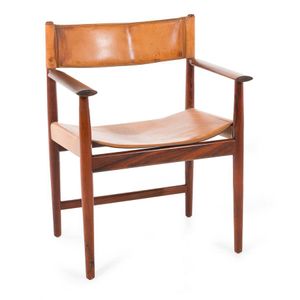Reeded Armchair with Leather Seat
George III Sheraton desk chair / armchair with reeded arms, on square tapered legs, seat reupholstered in black leather, 56 cm wide, 87 cm high
You must be a subscriber, and be logged in to view price and dealer details.
Subscribe Now to view actual auction price for this item
When you subscribe, you have the option of setting the currency in which to display prices to $Au, $US, $NZ or Stg.
This item has been sold, and the description, image and price are for reference purposes only.
- Tapered Legs - found on both cabinet and country-made furniture from the 18th to the later 19th centuries. The leg sometimes terminates in a spade foot, though on most country furniture the taper continues for the whole length of the leg. The important thing to remember is that the taper ought only to be on the inside face of the leg, and the outer face should be straight and square. Some legs were made where both sides tapered, but in such a case the taper ought to be the same on both the inner and outer faces of the leg. Where the inside of a leg is straight, with only the outer face tapering, there is every reason to be suspicious
- Thomas Sheraton - Thomas Sheraton (1751-1806) was born in Stockton on Tees in the north of England. He was apprenticed to a local cabinetmaker and after working as a cabinetmaker, Sheraton moved to London about 1790. Although he described himself as a cabinet-maker, like Chippendale, no definite piece of furniture can be traced to him as maker. Nevertheless, he was immensely influential and in 1791-4 published his four volume book 'The Cabinet-Maker and Upholsterer's Drawing Book'. The books were used as source of design by the furniture-making trade , who often simplified or modified the designs to suit their own preferences. Sheraton furniture is marked by restraint and sophistication, elegance and discretion, though he also found time to invent fanciful combination furniture.
- Reeding - A series of parallel, raised convex mouldings or bands, in section resembling a series of the letter 'm'. The opposite form of fluting, with which it is sometimes combined. Reeding is commonly found on chair legs, either turned or straight, on the arms and backs of chairs and couches and around table edges in the Neoclassical or Classical Revival manner. Reeding was also used as a form of decoration during the Edwardian period, but it is usually much shallower and evidently machine made.
- George Iii - George III (1738 - 1820) was King of Great Britain and Ireland from 1760 to 1820.
This item has been included into following indexes:
- chairs, singles - Georgian 542
-
chairs, singles / pairs / threes, style or period
- armchairs 1,732
- desk 288
- library 288
- office 288
- Sheraton syle 80
-
desks, period or age
- Georgian 132
- Sheraton style 26
Visually similar items

A marquetry inlaid armchair, Dutch, 19th century
Sold by
in
for
You can display prices in $Au, $US, $NZ or Stg.

Chippendale style mahogany elbow chair 19th century, maroon leather upholstery and stud work, height 93 cm
Sold by
in
for
You can display prices in $Au, $US, $NZ or Stg.

Mid century armchair, Distressed tan leather, Denmark, c 1960s, 80 cm high, 61 cm wide, 53 cm deep
Sold by
in
for
You can display prices in $Au, $US, $NZ or Stg.

An Australian carver chair, solid blackwood, early 20th century, 60 cm across the arms
Sold by
in
for
You can display prices in $Au, $US, $NZ or Stg.
